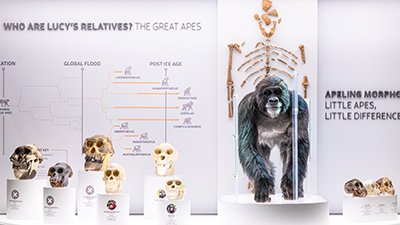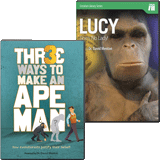
Lucy-Worship in Houston
Lucy in the Minds of Men (from the Houston Chronicle)
Lucy, the “holy grail” of evolution according to some pundits, has arrived and is now on display at the Houston Museum of Natural Science in Texas, her premiere attracting approximately 1,000 visitors to the museum last Friday, according to the Houston Chronicle. A duo of Chronicle articles (Lucy knows how to start a conversation and Houston’s newest (and oldest) visitor attracts about 1,000) offers some intriguing fodder for our analysis of the famous australopithecine.
“They don’t have any finger bones, so how do they know her hand was like that?”
To start, the Chronicle’s Lisa Falkenberg records a few of the diverse opinions overheard at the exhibit (fully titled “Lucy’s Legacy: The Hidden Treasures of Ethiopia”). First are two children (quoting at length):
[Ten]-year-old Garrett Bryant of Odessa peered down at the incomplete jigsaw puzzle of brittle bone fragments and looked disappointed.
“What happened to her skull?” he asked his mother.
“I imagine animals drug it off,” Marla Bryant answered.
She walked over to examine the lifelike 3 ½-foot, hairy, half-smiling model of what scientists believe Lucy looked like and had her own questions.
“They don’t have any finger bones, so how do they know her hand was like that?” Marla Bryant asked her mother, Leona Rice.
“They’re guessing,” Rice replied.
Young Garrett processed the scene for a few more minutes and then shrugged.
“She’s just a monkey,” he declared, and then walked off.
“I can’t imagine anybody leaving this exhibit and not believing that this is real.”
Falkenberg next turns to Deena Dail of Austin, Texas. Dail told Falkenberg she studied anthropology in college, and wept at Lucy’s “altar” (as Falkenberg analogizes the display):
“I can’t imagine anybody leaving this exhibit and not believing that this is real,” Dail said, her voice cracking, wiping tears under her glasses. “That's the cradle. We’re looking at humanity at its earliest point that we know of. And we’re seeing our ancestry, you know, everybody, regardless of race, religion, ethnicity, belief systems.”
Dail’s implication that some individuals (presumably she’s thinking of creationists) don’t believe Lucy is “real” (perhaps “authentic” is the better word) does not apply to those of us at Answers in Genesis (or any mainstream creationist organization that we are aware of). Although paleoanthropology has been plagued with hoaxes (e.g., Piltdown Man), we accept the existence and authenticity of most fossils; what we dispute are the allegations that such fossils are our ancestors and “indisputably” so many millions of years old, etc. We have cited numerous reasons why Lucy and her ilk are nothing more than apes (see, for example, Farewell to “Lucy”, Lucy (and her “child”)—look like extinct apes after all, and Lucy’s Child, “Selam,” from Ethiopia). And contrary to the effective thrust of evolutionary assertions, fossils do not come with dates tattooed on them!
Thus, Dail’s apparent leap in logic (at least, based on her words) is that because the fossil is real, it must be what evolutionists say it is, and it must be as old as evolutionists say it is.
Falkenberg concludes her story with the solemn head-shaking of Linda Piper, an Albuquerque, New Mexico, humanities professor, who claimed seeing Lucy “brought her closer to God”:
“Just to observe the whole evolutionary process, how wonderful it is. That we are all from the same being, the same construction, and the same energy and network of life. That we are not separated,” she said. “That we are one.”
Piper’s statements indicate that she is missing two things. First, her comment about “observ[ing] the whole evolutionary process” belies the true nature of the event: she is merely observing an unchanging, partial, contested fossil that some say is millions of years old and representative of ancestors of modern humans. The “evolutionary process” alleged to have happened between Lucy and Piper is just that: an allegation, unobserved, and (in not just our view) ultimately disproved. As Ken Ham reminds us in The Lie: Evolution, fossils exist in the present and are interpreted in the present! Ham explains:
It only takes common sense to understand that one does not dig up an “age of the dinosaurs” supposedly existing 70–200 million years ago. One digs up dead dinosaurs that exist now, not millions of years ago.
Fossil bones do not come with little labels attached telling you how old they are. Nor do fossils have photographs with them telling you what the animals looked like as they roamed the earth long ago.
When people visit a museum they are confronted by bits and pieces of bones and other fossils neatly arranged in glass cases. These are often accompanied by pictures representing an artist’s impression of what the animals and plants could have looked like in their natural environment. Remember, no one dug up the picture, just the fossils. And these fossils exist in the present.
Remember, no one dug up the picture, just the fossils.
Sound familiar? As for Piper’s second mistake, she glorifyingly claims this represents the unity of all life—yet apparently ignores the woeful violence, bloodshed, and death evolution is theoretically based on. Despite evolutionists’ attempts to laud evolution as a mystical, wonderful, lovable process, the fact remains that the evolutionary model is based on the cold, relentless, absolutely unlikable mechanism of natural selection—“survival of the fittest” (despite the common misrepresentation, evolution is not the same thing as natural selection).
Next, a single revealing dialog from Melanie Markley’s “Houston's newest (and oldest) visitor attracts about 1,000”:
Tracie Moreno said she and her father had been waiting a long time to see the display. When her 2-year-old daughter, Jasmine, looked at the life-size replica of Lucy and signed the word “monkey,” her mother just laughed.
“She can’t say ‘Australopithicus’ yet,” said Moreno, referring to Lucy’s scientific name.
(We’ll let that one speak for itself.)
So what, then, do we think of Lucy? Simply put, she couldn’t be man’s ancestor, because Genesis clearly states that man was made on the same day as all terrestrial animals. Period.
For more information:
Remember, if you see a news story that might merit some attention, let us know about it! (Note: if the story originates from the Associated Press, Fox News, MSNBC, the New York Times, or another major national media outlet, we will most likely have already heard about it.) And thanks to all of our readers who have submitted great news tips to us.
(Please note that links will take you directly to the source. Answers in Genesis is not responsible for content on the websites to which we refer. For more information, please see our Privacy Policy.)
Recommended Resources

Answers in Genesis is an apologetics ministry, dedicated to helping Christians defend their faith and proclaim the good news of Jesus Christ.
- Customer Service 800.778.3390
- © 2024 Answers in Genesis





